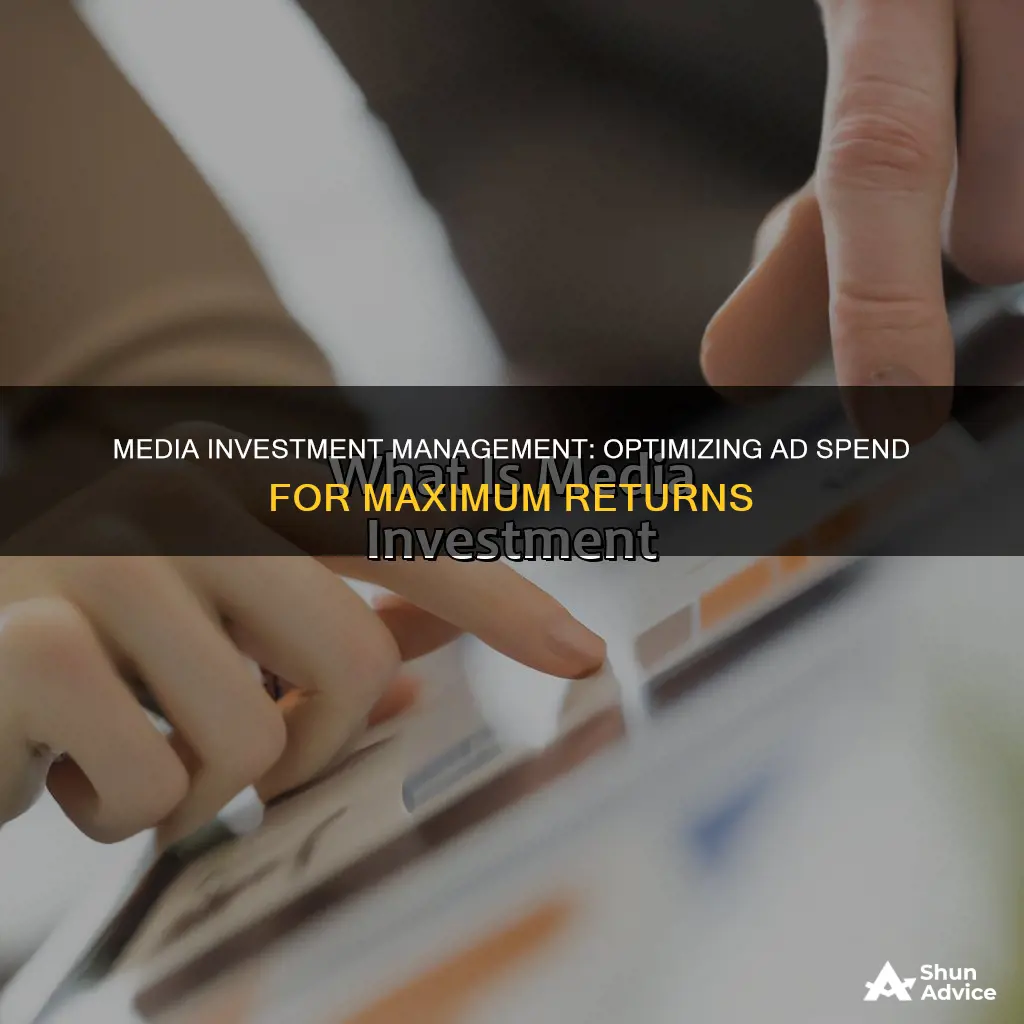
Media investment management involves managing a brand's advertising investments across digital and traditional media. It involves creating a media strategy, deciding on the allocation of budgets, and selecting the right media channels to target customers effectively. With the rise of digital media, the landscape of advertising has changed, and brands now need to navigate the complexities of online advertising while also maintaining their presence in traditional media. Media investment management aims to optimise advertising spend and increase the return on investment by utilising data analytics and understanding emerging media channels. The goal is to reach the target audience, build brand awareness, and ultimately, drive business growth.
| Characteristics | Values |
|---|---|
| Definition | Media investment management involves creating strategies for buying and selling media and investing in current and future media inventory. |
| Purpose | To execute media in future periods at aggressive rates compared to clients' current market benchmarks. |
| Benefits | Financial benefits for clients, valuable service to media providers, and more control over media investments for brands. |
| Challenges | Complexity of balancing digital and traditional advertising, lack of transparency in digital advertising, and difficulty measuring return on investment. |
| Importance | Media investments drive growth and make advertising more effective, especially with the rise of digital media and advanced data analytics. |
| Key Players | Media investment agencies like Evergreen Trading, GroupM, and MDIF. |
What You'll Learn

The pros and cons of digital advertising
Media investment management involves brands investing in digital media while also maintaining their position in traditional advertising. This can be challenging, given the constraints of advertising budgets and the complexities of the online world.
Digital advertising has numerous benefits, or pros, for brands. Firstly, it is often cheaper than traditional advertising, allowing businesses to reach their desired audience with a smaller budget. It also allows for specific customer targeting, with options to filter by location, interests, or age. This can be combined with geo-targeting, ensuring ads are only viewed and clicked by the intended audience.
Digital advertising also offers full control and accurate statistics. Marketers can set daily budgets, monitor spending, and know exactly how many people clicked on their ads and became customers. This removes the guesswork from advertising campaigns. Additionally, the wide range of formats available, such as banner ads, text ads, video ads, and social media contests, means there is an option for every business.
The online world also provides improved customer interaction. Customers can easily click on an ad, order a product, or seek additional information. They can also review and share products on social media, motivating more customers to shop. This instant gratification is a significant advantage of digital advertising.
However, there are also cons to digital advertising. Firstly, not everyone is on the internet or willing to share their data, and privacy laws must be followed. There is also limited space for ads, and competition for customer attention is fierce. The click-through rate is gradually decreasing, with many people actively blocking or ignoring ads.
Digital advertising can also be distracting to consumers and may not always load correctly. There is a lot of competition, and it can be challenging to stand out. Oversaturation is a significant issue, with many websites having numerous advertising feeds, causing "visitor blindness". It is also easy for internet users to block ads, and browser extensions are constantly adapting to work around advertising agencies' workarounds.
In conclusion, while digital advertising offers benefits such as lower costs, specific customer targeting, and improved customer interaction, it also has drawbacks, including competition for attention, distractions, and the ease with which ads can be blocked. Brands must carefully navigate these pros and cons to ensure a successful digital advertising campaign.
MFS Investment Management: Paying Primary Beneficiaries
You may want to see also

The importance of brand safety
Media investment management is a challenging field, especially with the rise of digital advertising. Marketers need to balance their investment in traditional advertising with digital advertising to avoid stretching their budgets too thin.
Digital advertising has brought about a revolution, allowing for more precise targeting and efficiency. However, it has also introduced new complexities, such as concerns over brand safety. Brand safety is essential to advertising effectiveness and can impact a brand's return on investment (ROI). Here's why brand safety is crucial:
Protecting Brand Reputation and Building Customer Trust
Placing ads in inappropriate or harmful contexts can hurt brand perception and erode customer trust. For example, a children's toy company would not want its ads displayed alongside violent or adult content. Similarly, a luxury brand may want to avoid low-quality or controversial sites that could tarnish its image. By ensuring brand safety, companies can protect their reputation and maintain the trust of their customers.
Financial Impact and Legal Risks
Misplaced ads can result in wasted budgets and hurt sales. Inappropriate ad placements can also lead to legal penalties and fines. For instance, if ads are displayed on pirate sites or alongside fake news, the brand may be held accountable. Therefore, brand safety is crucial for mitigating financial losses and legal consequences.
Audience Engagement and ROI
Unsafe ads can lower audience engagement and negatively impact ROI. When ads are placed in unsuitable environments, they may fail to reach the intended audience or be perceived negatively, resulting in lower engagement and sales. By ensuring brand safety, companies can maximize the impact of their advertising campaigns and improve their ROI.
Competitive Advantage and Global Consistency
Strong brand safety practices help build brand loyalty and set companies apart from their competitors. Additionally, ensuring brand safety across different markets, despite cultural and legal differences, is essential for maintaining a consistent global presence. By adhering to brand safety guidelines, companies can avoid PR disasters and maintain a positive brand image worldwide.
Crisis Prevention and Social Responsibility
Brand safety is about more than just the bottom line; it's also about ethical practices and crisis prevention. By ensuring that ads are placed in suitable contexts, companies can avoid controversial situations and support social responsibility. This helps to prevent PR disasters and demonstrates a commitment to ethical advertising practices.
In conclusion, brand safety is a critical aspect of media investment management. By implementing brand safety measures, companies can protect their reputation, build customer trust, improve ROI, gain a competitive edge, and avoid legal and ethical issues. By prioritizing brand safety, marketers can navigate the complex world of digital advertising and maximize the effectiveness of their campaigns.
Direct vs Portfolio Investment: Understanding the Key Differences
You may want to see also

The role of media investment agencies
Media investment agencies, or media agencies, are companies that help businesses execute and manage marketing plans to achieve their goals. They promote services and products and run paid media campaigns to increase market share and brand awareness, ultimately aiming to generate more revenue.
Media agencies are composed of advertising experts who know how to plan, place, and track the results of advertising campaigns across different mediums. These outlets can include traditional formats such as radio, print, and television, as well as modern platforms like paid search, email, and social media.
Media investment agencies have expert knowledge of how to market products or services and how to plan advertising campaigns to make the most of their clients' budgets. They act as an extension of their client's business, providing consulting services to help market products and services in the most efficient way possible.
There are three main types of media agencies: digital, traditional, and integrated. Traditional media agencies focus on established advertising strategies using non-digital channels such as newspapers, radio, television, and billboards. Digital media agencies, on the other hand, concentrate on internet and digital-based advertising through mobile devices and computers. Integrated media agencies offer a combination of both traditional and digital marketing strategies, giving them access to larger data sets and budgets, which results in better insights for running effective campaigns.
What Counts as an Asset in Your Investment Portfolio?
You may want to see also

The impact of media investments on independent media
Media investment management is a crucial aspect of the media landscape, particularly for independent media outlets. The impact of media investments on independent media is profound and far-reaching.
Firstly, media investments play a pivotal role in fostering independent media and, by extension, promoting free speech and democratic values. Independent media outlets rely on investments to sustain their operations and maintain their autonomy. By investing in these media organizations, investment funds and organizations like the Media Development Investment Fund (MDIF) empower them to produce and disseminate news, information, and diverse perspectives without bowing to political or corporate interests. This financial backing enables independent media to serve as a watchdog, holding those in power accountable and exposing corruption.
Secondly, media investments have a direct impact on the reach and influence of independent media. With sufficient funding, these media outlets can expand their audience, increase their distribution channels, and enhance their online presence. This, in turn, amplifies their voices and enables them to engage with a broader segment of society. Independent media play a crucial role in providing reliable and objective information to the public, especially in countries without a free press. Through their investigative journalism and unbiased reporting, they contribute to better governance and help foster informed decision-making among citizens.
However, the impact of media investments on independent media also presents challenges and risks. The influx of investment capital can lead to a concentration of media ownership, potentially threatening the editorial independence of media outlets. Additionally, the shift to digital media and the rise of social media platforms have transformed the advertising landscape. While digital advertising offers enhanced targeting capabilities and efficiency, it also introduces complexities in measuring return on investment. The lack of transparency in digital media investments can make it difficult for independent media to secure sustainable funding, as they compete with larger, better-resourced organizations.
To navigate these challenges, independent media must adapt to the evolving media landscape. This includes developing digital strategies, embracing new technologies, and exploring diverse funding sources. By doing so, they can remain financially viable while preserving their editorial integrity. Ultimately, the impact of media investments on independent media is a double-edged sword, offering both opportunities for growth and autonomy, as well as potential threats to their independence and long-term sustainability.
Create a Portfolio on Investing.com: A Step-by-Step Guide
You may want to see also

The challenges of balancing ad spend across digital and traditional media
Media investment management involves navigating the challenges of balancing ad spend across digital and traditional media. The digital revolution has created a new boom in advertising, with brands hoping to target their customers more than ever before. However, despite the promise of digital advertising, it has become increasingly complex. The challenge for brands is to invest in digital media while maintaining a presence in traditional advertising, all within the constraints of their advertising budgets.
Finding the right allocation of budget between digital and traditional media is difficult. Digital advertising allows for more precise targeting, making it more efficient. However, investing too heavily in one or the other can quickly deplete marketing budgets. For example, decreasing a brand's presence in traditional media too quickly can negatively impact its image. Additionally, the lack of transparency in digital advertising threatens brands' control over their media budgets. Leading advertisers struggle to measure viewership and ad impact, and it can be challenging to define reliable industry metrics to assess return on investment.
To address these challenges, brands need to take control of their media investments and enforce stricter engagement rules with ad agencies. They should also adopt a fundamentally new approach to understanding the return on marketing investment (ROMI) for digital media. This includes integrating customer data across media and channels and trimming cost bases. By answering questions like "How can we better allocate our spend?" and "Where should we invest or cut?", brands can make more informed decisions about their media investment strategies.
Furthermore, marketers should harmonize their digital and traditional media strategies. This involves understanding their target audiences across different generational groups and media channels. By ditching media silos and collaborating across departments, marketing teams can create a strategic media mix that aligns with audience behaviour and meets their campaign objectives.
Global Investment Portfolio: Understanding Your Worldwide Assets
You may want to see also
Frequently asked questions
Media investment management is a strategy that involves investing in media companies and helping them navigate the complex world of advertising, particularly in the digital age.
A media investment management agency works with media content providers and publishers to create a mutual win for their clients and the publishers. They invest in various media providers, taking on the risk of funding and commitment timing.
The rise of the internet, social media, and advanced data analytics has created a new boom in advertising. Brands now have the opportunity to target their customers more precisely than ever before. However, it has also become more complex, with companies needing to balance their investment in digital media and traditional advertising while maintaining transparency and integrity.
Media investment management offers a financial benefit to clients by enabling them to pay a portion of their media bill through trade generated from selling surplus assets. It also provides a valuable service to media providers by investing in their current and future inventory. Additionally, media investment management agencies can help publishers losing spend to identity-rich walled gardens by combining first-party client data with rich e-commerce, telco, and wireless data.
GroupM, the #1 global buyer of all media, invests more than $60 billion a year on behalf of its clients. They have a unique partnership approach with key global, regional, and local media vendors, allowing them to bridge the gap between their data and create stronger planning activation. Another example is Evergreen Trading, a media trading firm that works with media vendors to invest in their current and future inventory, taking on the risk ahead of market demand.







